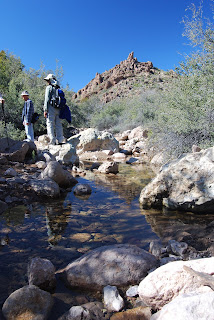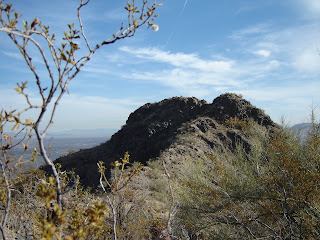


 HOLBERT TRAIL TO DOBBINS LOOKOUT Phoenix South Mountain Park Phoenicians are lucky to live within sight of the nation’s largest municipal park. South Mountain Park sprawls across our southern horizon and has hundreds of miles of trails that may be hiked individually or in combination loops. The Holbert Trail is easy to access and a cinch to follow due to excellent trail maintenance as well as strategically placed signage. From the trailhead, the path begins by traversing “petroglyph alley”. Keep one eye on the boulders and cliffs while hiking the first flat half-mile. Ancient rock art appears everywhere, as does the evidence of artifact thieves. Once past the petroglyphs, the hike becomes more strenuous as it follows the canyon walls and gently switchbacks uphill to the junction for Dobbins Lookout. The trail is rocky and can be tricky in places, so, pay attention. Hang a right at the signed junction and haul up more switchbacks to popular Dobbins Lookout. An old stone building and numerous vista points with benches make Dobbins Lookout a nice spot to rest and enjoy great view of the Valley of the Sun. Although the City of Phoenix provides ample reciprocals for trash, the lookout area, which is accessible via a paved road, is habitually coated with a layer of crap. Gatorade bottles, beer cans, candy wrappers, Doritos bags and the remnants of romantic interludes. Don’t ask. On our last hike to the lookout, we took along plastic trash bags and policed the area for rubbish but could do nothing about the graffiti. It's interesting to note that garbage and graffiti rarely occur in areas that are not accessible by car. Hey all you beer guzzling, littering, tossers; here’s something to ponder—how safe do you think it is to drink alcohol on the summit of a narrow, winding mountain road and then get back behind the wheel? Wheeeeeee! Just a thought. Anyhooo, I do digress. On our way back down the mountain, several young men who had driven to Dobbins Lookout were perched on the summit, cans in hand and fixated on us with our black trash bags as if we were mutant tree huggers. As we passed beneath them on our descent, I felt a slight “ping” on my backpack, but thought nothing of it. Later that day, when unloading and cleaning my pack, I noticed an aluminum pop-top ring in the mesh side pocket of my pack. It smelled of beer. LENGTH: 5.8 miles roundtrip DIFFICULTY: moderate ELEVATION: 1,350'-2,370'
HOLBERT TRAIL TO DOBBINS LOOKOUT Phoenix South Mountain Park Phoenicians are lucky to live within sight of the nation’s largest municipal park. South Mountain Park sprawls across our southern horizon and has hundreds of miles of trails that may be hiked individually or in combination loops. The Holbert Trail is easy to access and a cinch to follow due to excellent trail maintenance as well as strategically placed signage. From the trailhead, the path begins by traversing “petroglyph alley”. Keep one eye on the boulders and cliffs while hiking the first flat half-mile. Ancient rock art appears everywhere, as does the evidence of artifact thieves. Once past the petroglyphs, the hike becomes more strenuous as it follows the canyon walls and gently switchbacks uphill to the junction for Dobbins Lookout. The trail is rocky and can be tricky in places, so, pay attention. Hang a right at the signed junction and haul up more switchbacks to popular Dobbins Lookout. An old stone building and numerous vista points with benches make Dobbins Lookout a nice spot to rest and enjoy great view of the Valley of the Sun. Although the City of Phoenix provides ample reciprocals for trash, the lookout area, which is accessible via a paved road, is habitually coated with a layer of crap. Gatorade bottles, beer cans, candy wrappers, Doritos bags and the remnants of romantic interludes. Don’t ask. On our last hike to the lookout, we took along plastic trash bags and policed the area for rubbish but could do nothing about the graffiti. It's interesting to note that garbage and graffiti rarely occur in areas that are not accessible by car. Hey all you beer guzzling, littering, tossers; here’s something to ponder—how safe do you think it is to drink alcohol on the summit of a narrow, winding mountain road and then get back behind the wheel? Wheeeeeee! Just a thought. Anyhooo, I do digress. On our way back down the mountain, several young men who had driven to Dobbins Lookout were perched on the summit, cans in hand and fixated on us with our black trash bags as if we were mutant tree huggers. As we passed beneath them on our descent, I felt a slight “ping” on my backpack, but thought nothing of it. Later that day, when unloading and cleaning my pack, I noticed an aluminum pop-top ring in the mesh side pocket of my pack. It smelled of beer. LENGTH: 5.8 miles roundtrip DIFFICULTY: moderate ELEVATION: 1,350'-2,370' FACILITIES: restrooms, water, picnic tables, covered ramadas
GETTING THERE: From Phoenix, follow Central Avenue south all the way to the end where it flows into South Mountain Park. Just past the park entrance gate, turn left into the Activity Complex. Drive past the Interpretive Center and go all the way to the end of the road near the restrooms and park. The signed trailhead is directly across the road. South Mountain Park is open from 5:30 a.m to dusk and access and parking is free.
INFO: City of Phoenix Parks & Recreation:
http://phoenix.gov/parks/trails/locations/south/hiking/index.html



























